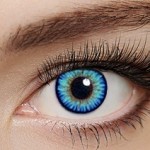Can Glasses Prescription Be Used to Order Contact Lenses?

Now, that’s a typical question a person experiencing vision problems usually asks. Here’s the common scenario – you visit an eye doctor who diagnoses you with short-sightedness (myopia) or far-sightedness (hyperopia). You obtain glasses prescriptions, order a pair and start wearing them. A few days later, someone suggests switching to contact lenses and you like the thought.
If you try to order the contacts based on the prescription you already have, there are two possibilities. Either you fail to obtain a pair or you end up buying an inappropriate one. So, the short answer to the above question is no, glass prescriptions are not the same as contact lens prescriptions. Read on for details.
The Obvious Difference in Placement
Isn’t it easy to understand? The contact lenses sit directly on the corneas, while the usual distance between the corneas and the glasses is 12-15 mm. Call it an insignificant difference, but it is a significant one in the world of optics. So, what happens if you try to buy contact lenses based on prescriptions for glasses? What you might get would be the contacts with a power stronger than required.
This can have some serious outcomes like:
- Uncomfortable vision
- Unstable images
- Irritation in the eyes
- Infections
- Severe loss of vision
Those ‘Extras’ in Contacts Prescriptions
If you ever get a chance to compare a glasses prescription with that meant for contacts, you would find the latter with some additional parameters, including:
Base Curve: Based on the shape of an eye, or cornea to be specific, the base curve allows obtaining contacts with precise fitting. It is because the parameter measures lens curvature that may differ from person to person. So, a base curve is an important specification to buy contacts that are neither too loose nor too tight.
Diameter: Along with the base curve, the lens diameter further defines the exact fitting of contacts. Specifying the overall size of the contacts, it may differ for soft contacts and glass permeable contacts.
Date of Expiration: A contact’s prescription has an expiry date as another parameter that can’t be compromised. In general, the contracts expire in a year or so, and then, you need to visit your doctor for the latest diagnoses. For this, you must have the right date in your knowledge.
Lens Material: What if you choose long-wear contact lenses? Does it make a difference if you are among forgetful people who sleep with contacts on? In such cases, you must have the right specification for contacts material. It is so because different materials offer different breathability levels, each apt for different kinds of uses.
Lend Brand: Usually, your contact prescription may specify lens brand instead of lens material. The purpose is the same, as both define the degree of breathability of the contacts based on your intended use.
The glasses prescription in your hand obviously has these parameters and specifications missing. So, it may not prove useful to order your new contacts.
The Case of Missing or Negative Cylinder
Another often ignored the difference between glasses prescription and contacts prescription can be the value of the cylinder. You may already know that only the patients with astigmatism have specifications like cylinder and axis in their prescriptions. The chances are that the same patient may have these values missing in his or her contacts prescriptions, while these may be present in his or her glasses prescriptions. Why so?
The simple answer to this lies with the brands/manufacturers of contact lenses. Many of them make toric contact lenses (required specifically for astigmatism patients) having power equal to -0.75 D. Thus, in case a patient with not-so-severe astigmatism requires low cylinder power, the cylinder specification is not needed to be taken into account. In such cases, the sphere power of the contacts would take care of tears and other irregularities in the cornea.
However, in case of severe astigmatism, a contact lens prescription may mention a cylinder value. The difference here is that a contacts prescription always has cylinder value in minus, while a glasses prescription may have this value as plus or minus. This is another reason why the latter may not let you buy the accurate contacts.
What You Should Do?
Switching from glasses to contacts can improve your routine and overall lifestyle. So, this transition must take place in the right way. Here are two suggestions:
- If a low power level can correct your vision, it may make sense to use prescriptions for glasses and contacts interchangeably. Still, you must consult a specialist to confirm the same.
- If the required powers are greater, say more than + or – 3.50 D, never take that chance. Make sure that you visit your doctor, get your eyes checked again, and obtain a fresh prescription for contact lenses.
The added benefit of obtaining new contact prescriptions is that your doctor may help you choose the right pair and also guide you on its better usage. This would undoubtedly make a difference in the way you see the world.






